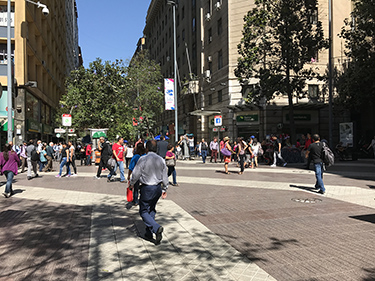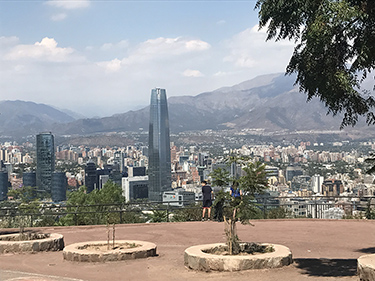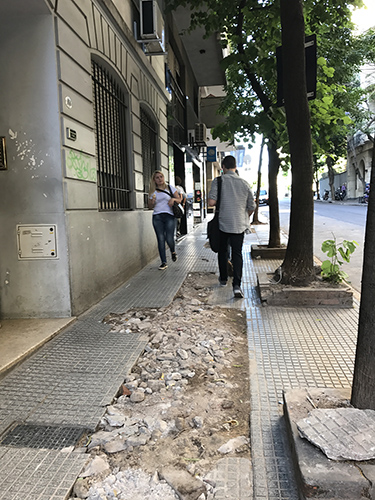|
Subscribe / Renew |
|
|
Contact Us |
|
| ► Subscribe to our Free Weekly Newsletter | |
| home | Welcome, sign in or click here to subscribe. | login |
Architecture & Engineering
| |

|
|
Design Perspectives By Clair Enlow |
January 11, 2017
Design Perspectives: A walk in Santiago offers lessons for other cities
Special to the Journal
It's summer in Buenos Aires and Santiago, and the walking is good.
Both of these large and proud metropolis on the south end of the globe have turbulent histories and rich cultural assets, including landmarks new and old. But if you look down, the sidewalks, streets and open spaces of both cities tell very different stories.
Buenos Aires is the bad boy to Santiago's overachiever.
Buenos Aires is a legendary city that never sleeps, but it's lonely on the sidewalks in the morning. That might be because they are difficult to negotiate. Sidewalks are uneven and squeezed in places, even though some streets have been recently narrowed from four to two lanes to make the walkways wider. Big dumpsters block the views.
Then there are the holes. On many side streets in central Buenos Aires, pavement is torn up in spots and scattered, like an abandoned construction site.
Why all the mess? It's hard to say for sure, but one local design professional offered some likely suspects: a strapped city budget, plus corruption. She cited some bad urban design decisions, like misguided investment in “opportunity zones,” such as office towers that are not well connected to transit and cut off from central city neighborhoods.
These recent problems are layered over structural issues like ramps and highway-scale streets that cut the city off from the waterfront, and longstanding swaths of “informal” development that is beyond the reach of city services and code enforcement.
More positive lessons can be found across the Andes, in the streets of Santiago. This city just keeps turning the page to something better.
Making strides
In recent years, Santiago has seen the construction of one sky-high tower with luxury shopping, but that doesn't keep citizens from turning out into the center city streets and parks at all hours of the day, most days of the week.
People obviously like it there. They carry smart phones, but also cluster around buskers and puppet theaters. They stroll, and sit on benches and at sidewalk tables, playing chess or even practicing yoga. There are children in groups, going to school, or eating cones and going to movies.
Traffic on the streets is intense, but mass transit is easy and pleasant, with new underground stations that are luxurious by any standards. There are new, sustainably built restrooms and bicycle lanes, too. It's clean. Litter may fall, but it's gone the next day.
Santiago calls itself “The City at the Bottom of the World,” but it gets top grades for civic health. And while the habits and culture of its citizens may be hard to replicate in places like Seattle, it holds lessons for all cities.
The devil is in the details. Capital construction is just the beginning: It has to be maintainable, and actually maintained. Who is accountable to whom? Are they watching? Are they walking? They're doing it all in Santiago.
Most of the paving and concrete in the right-of-way is obviously not new, but there are no gaps, rubble or other signs of neglect or unfinished construction. Dumpsters are out of sight, and litter is seldom seen.
Policemen and policewomen walk in pairs along streets and in squares, mixing with other pedestrians. They're approachable, friendly and professional.
Design is a high value, and gets legal support. But this is just part of a range of investments that make this city work.
Up-to-date building codes for the whole of Chile cover street infrastructure in Santiago, according to architect Rodrigo Diaz, who is from that city. They help keep the public realm smartly functional and accessible to all. It's not surprising that these up-to-date codes have also helped prevent damage in this earthquake prone part of the world, even in major quakes like the one last month in southern Chile, south of Santiago.
Housing is truly a right in modern Chile, according to Diaz, who has worked on housing in Santiago and Buenos Aires. For two decades, while Chile has enjoyed economic growth, a robust housing policy has moved people directly off the streets and into their own units, and also replaced informal development with permanent housing.
In their new homes, families pay on a sliding scale that simply removes economic barriers. For the poorest 20 percent of citizens, housing is subsidized 98 percent.
When it comes down to livability and the street environment, this may be the most important factor of all.
So it should come as no surprise then that unlike some other Latin American cities — including Buenos Aires — there is little “informal” development (slums) in Santiago.
Good designs and big investments are behind all good streets. So is good housing policy.
But the truth is on the pavement. In Buenos Aires and Santiago and great cities everywhere, it's the little things that count.
Clair Enlow can be reached by e-mail at clair@clairenlow.com.
Previous columns:
- Design Perspectives: Affordable housing is getting bigger and better, 11-30-2016
- Design Perspectives: ST3: Even at $54B, it's the only way to grow, 11-02-2016
- Design Perspectives: A path of great resistance in Steinbrueck Park, 10-12-2016
- Design Perspectives: Townhouses adding density to neighborhoods, 09-14-2016
- Design Perspectives: The future looks bright for Seattle's waterfront, 08-10-2016
- Design Perspectives: Occidental Park getting a great new neighbor, 07-27-2016
- Design Perspectives: Can we put a lid over our urban freeways?, 06-29-2016
- Design Perspectives -- District energy: Lots of talk, but still little action, 06-08-2016





